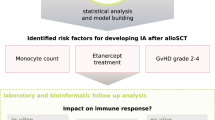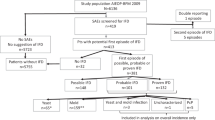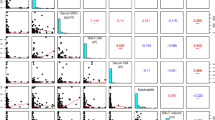Abstract
As culture-based methods for the diagnosis of invasive fungal diseases (IFD) in leukemia and hematopoietic SCT patients have limited performance, non-culture methods are increasingly being used. The third European Conference on Infections in Leukemia (ECIL-3) meeting aimed at establishing evidence-based recommendations for the use of biological tests in adult patients, based on the grading system of the Infectious Diseases Society of America. The following biomarkers were investigated as screening tests: galactomannan (GM) for invasive aspergillosis (IA); β-glucan (BG) for invasive candidiasis (IC) and IA; Cryptococcus Ag for cryptococcosis; mannan (Mn) Ag/anti-mannan (A-Mn) Ab for IC, and PCR for IA. Testing for GM, Cryptococcus Ag and BG are included in the revised EORTC/MSG (European Organization for Research and Treatment of Cancer/Mycoses Study Group) consensus definitions for IFD. Strong evidence supports the use of GM in serum (A II), and Cryptococcus Ag in serum and cerebrospinal fluid (CSF) (A II). Evidence is moderate for BG detection in serum (B II), and the combined Mn/A-Mn testing in serum for hepatosplenic candidiasis (B III) and candidemia (C II). No recommendations were formulated for the use of PCR owing to a lack of standardization and clinical validation. Clinical utility of these markers for the early management of IFD should be further assessed in prospective randomized interventional studies.
This is a preview of subscription content, access via your institution
Access options
Subscribe to this journal
Receive 12 print issues and online access
$259.00 per year
only $21.58 per issue
Buy this article
- Purchase on Springer Link
- Instant access to full article PDF
Prices may be subject to local taxes which are calculated during checkout
Similar content being viewed by others
References
De Pauw B, Walsh TJ, Donnelly JP, Stevens DA, Edwards JE, Calandra T et al. Revised definitions of invasive fungal disease from the European Organization for Research and Treatment of Cancer/Invasive Fungal Infections Cooperative Group and the National Institute of Allergy and Infectious Diseases Mycoses Study Group (EORTC/MSG) Consensus Group. Clin Infect Dis 2008; 46: 1813–1821.
ECIL. Recommendations for the use of biological markers for the diagnosis of invasive fungal infections in leukemic patients and hematopoietic stem cell transplant recipients. 2010 (http://www.ichs.org; http://www.eortc.be; http://www.ebmt.org; http://www.leukemia-net.org/content/home/).
Mennink-Kersten MA, Donnelly JP, Verweij PE . Detection of circulating galactomannan for the diagnosis and management of invasive aspergillosis. Lancet Infect Dis 2004; 4: 349–357.
Leeflang MM, Debets-Ossenkopp YJ, Visser CE, Scholten RJ, Hooft L, Bijlmer HA et al. Galactomannan detection for invasive aspergillosis in immunocompromised patients. Cochrane Database Syst Rev 2008: (8): CD007394.
Pfeiffer CD, Fine JP, Safdar N . Diagnosis of invasive aspergillosis using a galactomannan assay: a meta-analysis. Clin Infect Dis 2006; 42: 1417–1427.
Castagnola E, Furfaro E, Caviglia I, Licciardello M, Faraci M, Fioredda F et al. Performance of the galactomannan antigen detection test in the diagnosis of invasive aspergillosis in children with cancer or undergoing haemopoietic stem cell transplantation. Clin Microbiol Infect 2010; 16: 1197–1203.
Cordonnier C, Botterel F, Ben Amor R, Pautas C, Maury S, Kuentz M et al. Correlation between galactomannan antigen levels in serum and neutrophil counts in haematological patients with invasive aspergillosis. Clin Microbiol Infect 2009; 15: 81–86.
Herbrecht R, Letscher-Bru V, Oprea C, Lioure B, Waller J, Campos F et al. Aspergillus galactomannan detection in the diagnosis of invasive aspergillosis in cancer patients. J Clin Oncol 2002; 20: 1898–1906.
Meersseman W, Lagrou K, Maertens J, Wilmer A, Hermans G, Vanderschueren S et al. Galactomannan in bronchoalveolar lavage fluid: a tool for diagnosing aspergillosis in intensive care unit patients. Am J Respir Crit Care Med 2008; 177: 27–34.
Ascioglu S, Rex JH, de Pauw B, Bennett JE, Bille J, Crokaert F et al. Defining opportunistic invasive fungal infections in immunocompromised patients with cancer and hematopoietic stem cell transplants: an international consensus. Clin Infect Dis 2002; 34: 7–14.
Cordonnier C, Pautas C, Maury S, Vekhoff A, Farhat H, Suarez F et al. Empirical versus preemptive antifungal therapy for high-risk, febrile, neutropenic patients: a randomized, controlled trial. Clin Infect Dis 2009; 48: 1042–1051.
Maertens J, Theunissen K, Verhoef G, Verschakelen J, Lagrou K, Verbeken E et al. Galactomannan and computed tomography-based preemptive antifungal therapy in neutropenic patients at high risk for invasive fungal infection: a prospective feasibility study. Clin Infect Dis 2005; 41: 1242–1250.
Maertens JA, Klont R, Masson C, Theunissen K, Meersseman W, Lagrou K et al. Optimization of the cutoff value for the Aspergillus double-sandwich enzyme immunoassay. Clin Infect Dis 2007; 44: 1329–1336.
Koo S, Bryar JM, Baden LR, Marty FM . Prognostic features of galactomannan antigenemia in galactomannan-positive invasive aspergillosis. J Clin Microbiol 2010; 48: 1255–1260.
Maertens J, Maertens V, Theunissen K, Meersseman W, Meersseman P, Meers S et al. Bronchoalveolar lavage fluid galactomannan for the diagnosis of invasive pulmonary aspergillosis in patients with hematologic diseases. Clin Infect Dis 2009; 49: 1688–1693.
Marr KA, Laverdiere M, Gugel A, Leisenring W . Antifungal therapy decreases sensitivity of the Aspergillus galactomannan enzyme immunoassay. Clin Infect Dis 2005; 40: 1762–1769.
Ellis M, Al-Ramadi B, Finkelman M, Hedstrom U, Kristensen J, Ali-Zadeh H et al. Assessment of the clinical utility of serial beta-D-glucan concentrations in patients with persistent neutropenic fever. J Med Microbiol 2008; 57: 287–295.
Kami M, Tanaka Y, Kanda Y, Ogawa S, Masumoto T, Ohtomo K et al. Computed tomographic scan of the chest, latex agglutination test and plasma (1AE3)-beta-D-glucan assay in early diagnosis of invasive pulmonary aspergillosis: a prospective study of 215 patients. Haematologica 2000; 85: 745–752.
Kawazu M, Kanda Y, Nannya Y, Aoki K, Kurokawa M, Chiba S et al. Prospective comparison of the diagnostic potential of real-time PCR, double-sandwich enzyme-linked immunosorbent assay for galactomannan, and a (1 → 3)-beta-D-glucan test in weekly screening for invasive aspergillosis in patients with hematological disorders. J Clin Microbiol 2004; 42: 2733–2741.
Koo S, Bryar JM, Page JH, Baden LR, Marty FM . Diagnostic performance of the (1 → 3)-beta-D-glucan assay for invasive fungal disease. Clin Infect Dis 2009; 49: 1650–1659.
Obayashi T, Negishi K, Suzuki T, Funata N . Reappraisal of the serum (1 → 3)-beta-D-glucan assay for the diagnosis of invasive fungal infections--a study based on autopsy cases from 6 years. Clin Infect Dis 2008; 46: 1864–1870.
Obayashi T, Yoshida M, Mori T, Goto H, Yasuoka A, Iwasaki H et al. Plasma (1 → 3)-beta-D-glucan measurement in diagnosis of invasive deep mycosis and fungal febrile episodes. Lancet 1995; 345: 17–20.
Odabasi Z, Mattiuzzi G, Estey E, Kantarjian H, Saeki F, Ridge RJ et al. Beta-D-glucan as a diagnostic adjunct for invasive fungal infections: validation, cutoff development, and performance in patients with acute myelogenous leukemia and myelodysplastic syndrome. Clin Infect Dis 2004; 39: 199–205.
Ostrosky-Zeichner L, Alexander BD, Kett DH, Vazquez J, Pappas PG, Saeki F et al. Multicenter clinical evaluation of the (1 → 3) beta-D-glucan assay as an aid to diagnosis of fungal infections in humans. Clin Infect Dis 2005; 41: 654–659.
Persat F, Ranque S, Derouin F, Michel-Nguyen A, Picot S, Sulahian A . Contribution of the (1 → 3)-beta-D-glucan assay for diagnosis of invasive fungal infections. J Clin Microbiol 2008; 46: 1009–1013.
Senn L, Robinson JO, Schmidt S, Knaup M, Asahi N, Satomura S et al. 1,3-Beta-D-glucan antigenemia for early diagnosis of invasive fungal infections in neutropenic patients with acute leukemia. Clin Infect Dis 2008; 46: 878–885.
Lamoth F, Cruciani M, Mengoli C, Castagnola E, Lortholary O, Richardson M et al. Beta-glucan antigenemia for the diagnosis of invasive fungal infections in patients with hematological malignancies: systematic review and meta-analysis of cohort studies. Clin Infect Dis 2011 (accepted).
Babady NE, Bestrom JE, Jespersen DJ, Jones MF, Beito EM, Binnicker MJ et al. Evaluation of three commercial latex agglutination kits and a commercial enzyme immunoassay for the detection of cryptococcal antigen. Med Mycol 2009; 47: 336–338.
Chayakulkeeree M, Perfect JR . Cryptococcosis. Infect Dis Clin North Am 2006; 20: 507–544.
Antinori S, Galimberti L, Magni C, Casella A, Vago L, Mainini F et al. Cryptococcus neoformans infection in a cohort of Italian AIDS patients: natural history, early prognostic parameters, and autopsy findings. Eur J Clin Microbiol Infect Dis 2001; 20: 711–717.
Chuang YM, Ho YC, Chang HT, Yu CJ, Yang PC, Hsueh PR . Disseminated cryptococcosis in HIV-uninfected patients. Eur J Clin Microbiol Infect Dis 2008; 27: 307–310.
Dromer F, Mathoulin-Pelissier S, Launay O, Lortholary O . Determinants of disease presentation and outcome during cryptococcosis: the CryptoA/D study. PLoS Med 2007; 4: e21.
Husain S, Wagener MM, Singh N . Cryptococcus neoformans infection in organ transplant recipients: variables influencing clinical characteristics and outcome. Emerg Infect Dis 2001; 7: 375–381.
Jongwutiwes U, Sungkanuparph S, Kiertiburanakul S . Comparison of clinical features and survival between cryptococcosis in human immunodeficiency virus (HIV)-positive and HIV-negative patients. Jpn J Infect Dis 2008; 61: 111–115.
Pappas PG, Perfect JR, Cloud GA, Larsen RA, Pankey GA, Lancaster DJ et al. Cryptococcosis in human immunodeficiency virus-negative patients in the era of effective azole therapy. Clin Infect Dis 2001; 33: 690–699.
Vilchez R, Shapiro R, McCurry K, Kormos R, Abu-Elmagd K, Fung J et al. Longitudinal study of cryptococcosis in adult solid-organ transplant recipients. Transpl Int 2003; 16: 336–340.
Jaye DL, Waites KB, Parker B, Bragg SL, Moser SA . Comparison of two rapid latex agglutination tests for detection of cryptococcal capsular polysaccharide. Am J Clin Pathol 1998; 109: 634–641.
Tanner DC, Weinstein MP, Fedorciw B, Joho KL, Thorpe JJ, Reller L . Comparison of commercial kits for detection of cryptococcal antigen. J Clin Microbiol 1994; 32: 1680–1684.
Kontoyiannis DP . What is the significance of an isolated positive cryptococcal antigen in the cerebrospinal fluid of cancer patients? Mycoses 2003; 46: 161–163.
Klis FM . Review: cell wall assembly in yeast. Yeast 1994; 10: 851–869.
Jacquinot PM, Plancke Y, Sendid B, Strecker G, Poulain D . Nature of Candida albicans-derived carbohydrate antigen recognized by a monoclonal antibody in patient sera and distribution over Candida species. FEMS Microbiol Lett 1998; 169: 131–138.
Sendid B, Tabouret M, Poirot JL, Mathieu D, Fruit J, Poulain D . New enzyme immunoassays for sensitive detection of circulating Candida albicans mannan and antimannan antibodies: useful combined test for diagnosis of systemic candidiasis. J Clin Microbiol 1999; 37: 1510–1517.
Alam FF, Mustafa AS, Khan ZU . Comparative evaluation of (1, 3)-beta-D-glucan, mannan and anti-mannan antibodies, and Candida species-specific snPCR in patients with candidemia. BMC Infect Dis 2007; 7: 103.
Ellis M, Al-Ramadi B, Bernsen R, Kristensen J, Alizadeh H, Hedstrom U . Prospective evaluation of mannan and anti-mannan antibodies for diagnosis of invasive Candida infections in patients with neutropenic fever. J Med Microbiol 2009; 58: 606–615.
Fujita S, Takamura T, Nagahara M, Hashimoto T . Evaluation of a newly developed down-flow immunoassay for detection of serum mannan antigens in patients with candidaemia. J Med Microbiol 2006; 55: 537–543.
Oliveri S, Trovato L, Betta P, Romeo MG, Nicoletti G . Experience with the Platelia Candida ELISA for the diagnosis of invasive candidosis in neonatal patients. Clin Microbiol Infect 2008; 14: 391–393.
Persat F, Topenot R, Piens MA, Thiebaut A, Dannaoui E, Picot S . Evaluation of different commercial ELISA methods for the serodiagnosis of systemic candidosis. Mycoses 2002; 45: 455–460.
Prella M, Bille J, Pugnale M, Duvoisin B, Cavassini M, Calandra T et al. Early diagnosis of invasive candidiasis with mannan antigenemia and antimannan antibodies. Diagn Microbiol Infect Dis 2005; 51: 95–101.
Sendid B, Caillot D, Baccouch-Humbert B, Klingspor L, Grandjean M, Bonnin A et al. Contribution of the Platelia Candida-specific antibody and antigen tests to early diagnosis of systemic Candida tropicalis infection in neutropenic adults. J Clin Microbiol 2003; 41: 4551–4558.
Sendid B, Dotan N, Nseir S, Savaux C, Vandewalle P, Standaert A et al. Antibodies against glucan, chitin, and Saccharomyces cerevisiae mannan as new biomarkers of Candida albicans infection that complement tests based on C. albicans mannan. Clin Vaccine Immunol 2008; 15: 1868–1877.
Sendid B, Jouault T, Coudriau R, Camus D, Odds F, Tabouret M et al. Increased sensitivity of mannanemia detection tests by joint detection of alpha- and beta-linked oligomannosides during experimental and human systemic candidiasis. J Clin Microbiol 2004; 42: 164–171.
Sendid B, Poirot JL, Tabouret M, Bonnin A, Caillot D, Camus D et al. Combined detection of mannanaemia and antimannan antibodies as a strategy for the diagnosis of systemic infection caused by pathogenic Candida species. J Med Microbiol 2002; 51: 433–442.
Verduyn Lunel FM, Donnelly JP, van der Lee HA, Blijlevens NM, Verweij PE . Circulating Candida-specific anti-mannan antibodies precede invasive candidiasis in patients undergoing myelo-ablative chemotherapy. Clin Microbiol Infect 2009; 15: 380–386.
White PL, Archer AE, Barnes RA . Comparison of non-culture-based methods for detection of systemic fungal infections, with an emphasis on invasive Candida infections. J Clin Microbiol 2005; 43: 2181–2187.
Yera H, Sendid B, Francois N, Camus D, Poulain D . Contribution of serological tests and blood culture to the early diagnosis of systemic candidiasis. Eur J Clin Microbiol Infect Dis 2001; 20: 864–870.
Mikulska M, Calandra T, Sanguinetti M, Poulain D, Viscoli C . Mannan antigen and anti-mannan antibodies in the diagnosis of invasive candidiasis: recommendations from the third European Conference on Infections in Leukemia. Crit Care 2010; 14: R222.
Bretagne S, Costa JM . Towards a molecular diagnosis of invasive aspergillosis and disseminated candidosis. FEMS Immunol Med Microbiol 2005; 45: 361–368.
Bustin SA, Benes V, Garson JA, Hellemans J, Huggett J, Kubista M et al. The MIQE guidelines: minimum information for publication of quantitative real-time PCR experiments. Clin Chem 2009; 55: 611–622.
Bretagne S . Advances and prospects for molecular diagnostics of fungal infections. Curr Infect Dis Rep 2011; 12: 430–436.
Mengoli C, Cruciani M, Barnes RA, Loeffler J, Donnelly JP . Use of PCR for diagnosis of invasive aspergillosis: systematic review and meta-analysis. Lancet Infect Dis 2009; 9: 89–96.
Barnes RA, White PL, Bygrave C, Evans N, Healy B, Kell J . Clinical impact of enhanced diagnosis of invasive fungal disease in high-risk haematology and stem cell transplant patients. J Clin Pathol 2009; 62: 64–69.
Hebart H, Klingspor L, Klingebiel T, Loeffler J, Tollemar J, Ljungman P et al. A prospective randomized controlled trial comparing PCR-based and empirical treatment with liposomal amphotericin B in patients after allo-SCT. Bone Marrow Transplant 2009; 43: 553–561.
Tuon FF . A systematic literature review on the diagnosis of invasive aspergillosis using polymerase chain reaction (PCR) from bronchoalveolar lavage clinical samples. Rev Iberoam Micol 2007; 24: 89–94.
White PL, Bretagne S, Klingspor L, Melchers WJ, McCulloch E, Schulz B et al. Aspergillus PCR: one step closer to standardization. J Clin Microbiol 2010; 48: 1231–1240.
White PL, Perry MD, Loeffler J, Melchers W, Klingspor L, Bretagne S et al. The critical stages of extracting DNA from Aspergillus fumigatus in whole blood specimens. J Clin Microbiol 2010; 48: 3753–3755.
Acknowledgements
The ECIL Organization Committee is indebted to the companies that supported the expert meetings through educational grants since ECIL 1 in 2005: Astellas Pharma, Bristol-Myers Squibb, Cephalon, Gilead Sciences, Glaxo-Smith Kline Beecham, MSD, Novartis, Pfizer, Schering-Plough, Wyeth, Zeneus-Pharma and Cephalon. We are thankful to Jean-Michel Gosset and the staff of KOBE, Group GL events, Lyon, France for the organization of the meetings. We are also indebted to the participants of the ECIL 3 meeting: Murat Akova, Turkey; Maiken Arendrup, Denmark; Jacques Bille, Switzerland; Catherine Cordonnier, France; Oliver A Cornely, Germany; Eric Dannaoui, France; Rafael De La Camara, Spain; Emma Dellow (Gilead Sciences), UK; Lubos Drgona, Slovakia; Hermann Einsele, Germany; Dan Engelhard, Israel; Ursula Flückiger, Switzerland; Bertrand Gachot, France; Jesus Gonzales-Moreno (MSD), Spain; Andreas Groll, Germany; Ina Hanel (Astellas), Germany; Raoul Herbrecht, France; Claus-Peter Heussel, Germany; Christopher Kibbler, UK; Nikolai Klimko, Russia Michal Kouba, Czech Republic; Fanny Lanternier, France; Alexey Maschan, Russia; Livio Pagano, Italy; Goergios Petrikos, Greece; Zdenek Racil, Czech Republic; Pierre Reusser, Switzerland; Patricia Ribaud, France; Valérie Rizzi-Puechal (Pfizer), France; Markus Ruhnke, Germany; Janos Sinko, Hungary; Anna Skiada, Greece; Jan Styczynski, Poland; Anne Thiebaut, France; Janice Wahl (Schering-Plough) USA; Katherine Ward, UK.
Author information
Authors and Affiliations
Consortia
Corresponding author
Ethics declarations
Competing interests
Oscar Marchetti received unrestricted research grants and/or educational grants and/or speaker's honoraria and/or consultant's honoraria from the Foundation for the Advancement in Medical Microbiology and Infectious Diseases, FAMMID, Lausanne, Switzerland, Associates of Cape Code, BioMérieux—Cepheid, Bio-Rad, Wako, and Roche Diagnostics. Stéphane Bretagne received consultant's honoraria from Myconostica. The remaining authors declare no conflict of interest.
Appendix
Appendix
ECIL Laboratory Working Groups
The ECIL is a common initiative of the following groups or organizations: the Infectious Diseases Working Party of the European Group for Blood and Marrow Transplantation (EBMT-IDWP), the Infectious Diseases Group of the European Organization for Research and Treatment of Cancer (EORTC-IDG), the European Leukemia Net (ELN) (EU Grant Number: LSHC-CT-2004) and the International Immunocompromised Host Society (ICHS).
Galactomannan: Paul Verweij (leader), Lena Klingspor, Thomas Lehrnbecher, Johan Maertens.
β-glucan: Oscar Marchetti (leader), Frédéric Lamoth, Mario Cruciani, Elio Castagnola, Olivier Lortholary, Malcolm Richardson.
Cryptococcus antigen and mannan antigen/anti-mannan antibodies: Claudio Viscoli (leader), Malgorzata Mikulska, Maurizio Sanguinetti, Daniel Poulain, Thierry Calandra.
PCR for the diagnosis of invasive aspergillosis: Stéphane Bretagne (leader), Rosemary Barnes, Manuel Cuenca-Estrella, Peter Donnelly, Brian Jones, Lena Klingspor, Thomas Lehrnbecher, Juergen Loeffler, Johan Maertens, Paul Verweij, Philipe Lewis White.
Rights and permissions
About this article
Cite this article
Marchetti, O., Lamoth, F., Mikulska, M. et al. ECIL recommendations for the use of biological markers for the diagnosis of invasive fungal diseases in leukemic patients and hematopoietic SCT recipients. Bone Marrow Transplant 47, 846–854 (2012). https://doi.org/10.1038/bmt.2011.178
Received:
Revised:
Accepted:
Published:
Issue Date:
DOI: https://doi.org/10.1038/bmt.2011.178



